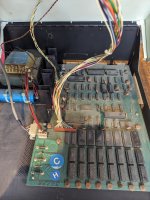automaticbirds
Member
Hi all, I am new to the forum! I have just purchased this PET, and yesterday nervously switched it on. The first time I got the basic screen saying 4032.031 bytes of ram (wrong) and only a few keys working. I pressed enter and got 'error' and the machine froze. So I switched off and back on. This time a flash of random characters and then a blank screen. Dusty board attached! Nervous about another switch on. Shall I clean, remove chips next? The rams are 6550, can I test these? Thanks all!


